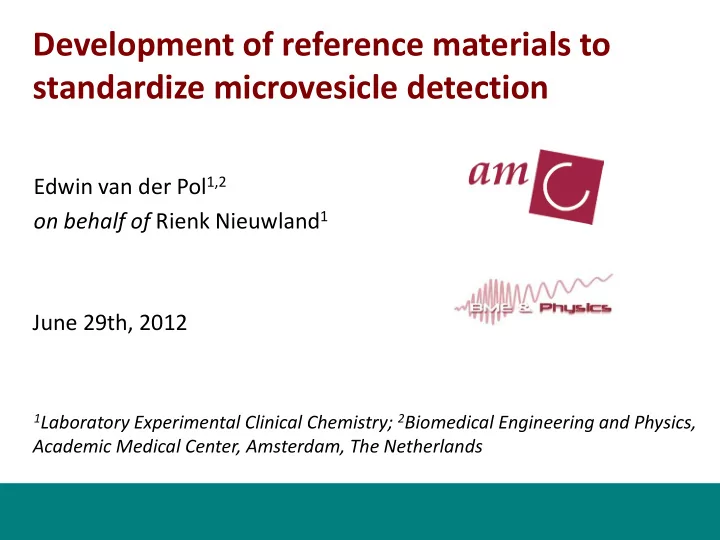

Development of reference materials to standardize microvesicle detection Edwin van der Pol 1,2 on behalf of Rienk Nieuwland 1 June 29th, 2012 1 Laboratory Experimental Clinical Chemistry; 2 Biomedical Engineering and Physics, Academic Medical Center, Amsterdam, The Netherlands 1
Disclosures for Edwin van der Pol In compliance with COI policy, ISTH requires the following disclosures to the session audience: Research Support/P.I. No relevant conflicts of interest to declare Employee No relevant conflicts of interest to declare Consultant No relevant conflicts of interest to declare Major Stockholder No relevant conflicts of interest to declare Speakers Bureau No relevant conflicts of interest to declare Honoraria No relevant conflicts of interest to declare Scientific Advisory Board No relevant conflicts of interest to declare Presentation includes discussion of the following off-label use of a drug or medical device: 2 <N/A>
Introduction 3
Metrology for health call 2011 support reliable and efficient exploitation of diagnostic and therapeutic techniques and development of new technologies to improve healthcare metrology is the science of measurement 4
Metrological characterization of microvesicles from body fluids as non-invasive diagnostic biomarkers 5
Letters of Support 6
Aim develop reliable, comparable and quantitative analysis of microvesicles in biological fluids development of isolation procedures dimensional characterization characterization of the chemical composition, morphology and concentration selection, characterization and distribution of reference materials 7
Work packages 8
Work package 1 development and application of procedures for microvesicle isolation 9
Work package 2 dimensional characterization of microvesicles and reference materials free in suspension (nanoparticle tracking analysis, resistive pulse sensing, small angle X-ray scattering) adhered to a surface dried conditions (atomic force microscopy, (transmission) scanning electron microscopy) wet conditions (atomic force microscopy) 10
11
Small angle X-ray scattering beam stop sample capillary monochromator X-ray source X-ray optics 2D detector proteins 8 nm Intensity (a.u.) Intensity (a.u.) membrane proteins core 50 nm Q (nm -1 ) Q (nm -1 ) Calculations: Bouwstra et al. Chem. Phys. Lip. 64 , 83-98 (1993) 12
Work package 3 chemical analysis, morphology, and concentration of microvesicles chemical analysis (anomalous small angle x-ray scattering, X-ray fluorescence) cellular origin and type (atomic force microscopy with functionalized tips) morphology dried conditions (atomic force microscopy, transmission electron microscopy) wet conditions (atomic force microscopy) concentration (nanoparticle tracking analysis, resistive pulse sensing) 13
Work package 4 development and distribution of traceable reference materials Reference material Size Concentration Density Refractive index (ml -1 ) (g/cm 3 ) (nm) @530 nm Synthetic particles • polystyrene beads 1x10 10 – 1x10 14 30 – 1,000 1.05 1.599 • silica beads 30 – 1,000 1x10 10 – 1x10 14 2.00 1.461 biological particles • Intralipid 25 – 700 ~1x10 14 0.93 1.465 • purified vesicles 30 – 1,000 variable 1.13-1.19 not known inter metrological laboratory comparison inter clinical laboratory comparison 14
Inter clinical laboratory comparison goal validate developed protocols and detection methods in clinical laboratories using traceable reference materials distribution September and December 2014 data collection and analysis in January and February 2015 results report and peer-reviewed article 15
Participation To participate in this SSC survey, please send an e-mail to r.nieuwland@amc.uva.nl before October 1st 2012. Please include your name and affiliations available detection method(s) 16
Recommend
More recommend